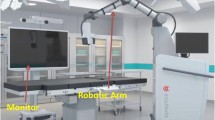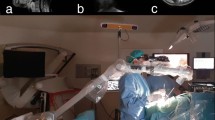Abstract
Purpose
Vision and ergonomics are crucial variables for successful outcomes during neurosurgery procedures. Two-dimension video telescope operating monitor (VITOM) exoscope has emerged as an alternative, which is cheaper than microscope. The aim of this study is to evaluate the clinical utility of 2D VITOM and to compare its merits and demerits with respect to microscope.
Methods
VITOM 2D (Karl Storz, Germany) was used in 9 cranial and 5 spinal pediatric cases. While KINEVO operative microscope (Carl Zeiss, Germany) was used in 12 cranial and 6 spinal pediatric patients. All surgeries were performed by single senior neurosurgeon. The author’s experience and opinions, as well as qualitative data, were analyzed. A comparison was made on image quality, illumination, field of view, and magnification of the operative field and ergonomics.
Results
Seven out of 9 cranial pediatric cases were switched from VITOM 2D to operative microscope due to low-image definition in depth of cranial cavity. Poor visualization of bleeding source in surgical field was another major drawback. Two cranial cases in which exoscope were used exclusively, included superficial tumors. In all 5 spinal cases, VITOM 2D was successfully used without any major difficulty. The exoscope’s advantages were observed in ergonomics and ease in switching to naked eyes, but the microscope’s field of view, illumination, magnification, and user-friendliness was considered superior.
Conclusion
2D-VITOM is best suited for spinal and superficial cranial tumors. However, a lot of modifications are to be done especially in optics to become a substitute for operative microscope.

Similar content being viewed by others
Data availability
The data associated with the paper are not publicly available but are available from the corresponding author on reasonable request.
Change history
30 August 2022
A Correction to this paper has been published: https://doi.org/10.1007/s00381-022-05655-9
References
Rossini Z, Cardia A, Milani D, Lasio GB, Fornari M, D’Angelo V (2017) VITOM 3D: preliminary experience in cranial surgery. World Neurosurg 107:663–668
Abunimer AM, Abou-Al-Shaar H, White TG, Park J, Schulder M (2022) The utility of high-definition 2-dimensional stereotactic exoscope in cranial and spinal procedures. World Neurosurg 158:e231–e236
Sack J, Steinberg JA, Rennert RC, Hatefi D, Pannell JS, Levy M, Khalessi AA (2018) Initial experience using a high-definition 3-dimensional exoscope system for microneurosurgery. Oper Neurosurg (Hagerstown) 14:395–401
Burkhardt BW, Csokonay A, Oertel JM (2020) 3D-exoscopic visualization using the VITOM-3D in cranial and spinal neurosurgery. What are the limitations? Clin Neurol Neurosurg 198:106101
Ricciardi L, Chaichana KL, Cardia A, Stifano V, Rossini Z, Olivi A, Sturiale CL (2019) The exoscope in neurosurgery: an innovative “point of view”. A systematic review of the technical, surgical, and educational aspects. World Neurosurg 124:136–144
Yoon WS, Lho HW, Chung DS (2021) Evaluation of 3-dimensional exoscopes in brain tumor surgery. J Korean Neurosurg Soc 64:289–296
Montemurro N, Scerrati A, Ricciardi L, Trevisi G (2021) The exoscope in neurosurgery: an overview of the current literature of intraoperative use in brain and spine surgery. J Clin Med 11:223
Khalessi AA, Rahme R, Rennert RC, Borgas P, Steinberg JA, White TG, Santiago-Dieppa DR, Boockvar JA, Hatefi D, Pannell JS, Levy M (2019) First-in-man clinical experience using a high-definition 3-dimensional exoscope system for microneurosurgery. Oper Neurosurg (Hagerstown) 16:717–725
Beez T, Munoz-Bendix C, Beseoglu K, Steiger HJ, Ahmadi SA (2018) First clinical applications of a high-definition three-dimensional exoscope in pediatric neurosurgery. Cureus 10:e2108
Parihar V, Yadav YR, Kher Y, Ratre S, Sethi A, Sharma D (2016) Learning neuroendoscopy with an exoscope system (video telescopic operating monitor): Early clinical results. Asian J Neurosurg 11:421–426
Oertel JM, Burkhardt BW (2017) Vitom-3D for exoscopic neurosurgery: initial experience in cranial and spinal procedures. World Neurosurg 105:153–162
Oertel J, Keiner D (2021) Novel devices for intraoperative visualization in neurosurgical procedures: current state and prospect of using the exoscope. Acta Neurochir (Wien) 163:2117–2119
Kwan K, Schneider JR, Du V, Falting L, Boockvar JA, Oren J, Levine M, Langer DJ (2019) Lessons learned using a high-definition 3-dimensional exoscope for spinal surgery. Oper Neurosurg (Hagerstown) 16:619–625
D’Ercole M, Serchi E, Zanello M, Tufo T, Sturiale C (2020) Clinical application of a high definition three-dimensional exoscope in anterior lumbar interbody fusion. Int J Spine Surg 14:1003–1008
Rösler J, Georgiev S, Roethe AL, Chakkalakal D, Acker G, Dengler NF, Prinz V, Hecht N, Faust K, Schneider U, Bayerl S (2022) Clinical implementation of a 3D4K-exoscope (Orbeye) in microneurosurgery. Neurosurg Rev 45:627–635
Palumbo VD, Fazzotta S, Damiano G, Lo Monte AI (2018) VITOM® 3D system in surgeon microsurgical vascular training: our model and experience. J Vasc Access 19:108–109
Bakhsheshian J, Strickland BA, Jackson C, Chaichana KL, Young R, Pradilla G, Chen JW, Bailes J, Zada G (2019) Multicenter investigation of channel-based subcortical trans-sulcal exoscopic resection of metastatic brain tumors: a retrospective case series. Oper Neurosurg (Hagerstown) 16:159–166
Jackson C, Gallia GL, Chaichana KL (2017) Minimally invasive biopsies of deep-seated brain lesions using tubular retractors under exoscopic visualization. J Neurol Surg Part A: Central Eur Neurosurg 78(06):588–594
Murakami T, Toyota S, Nakagawa K, Hagioka T, Hoshikuma Y, Suematsu T, Shimizu T, Kobayashi M, Taki T (2022) Midline suboccipital approach to a vertebral artery–posterior inferior cerebellar artery aneurysm from the rostral end of the patient using ORBEYE. Surg Neurol Int 13:87
Birch K, Drazin D, Black KL, Williams J, Berci G, Mamelak AN (2014) Clinical experience with a high definition exoscope system for surgery of pineal region lesions. J Clin Neurosci 21:1245–1249
Krishnan KG, Schöller K, Uhl E (2017) Application of a compact high-definition exoscope for illumination and magnification in high-precision surgical procedures. World Neurosurg 97:652–660
Iyer R, Chaichana KL (2018) Minimally invasive resection of deep-seated high-grade gliomas using tubular retractors and exoscopic visualization. J Neurol Surg A Cent Eur Neurosurg 79:330–336
Shirzadi A, Mukherjee D, Drazin DG, Paff M, Perri B, Mamelak AN, Siddique K (2012) Use of the video telescope operating monitor (VITOM) as an alternative to the operating microscope in spine surgery. Spine 37:E1517-1523
Siller S, Zoellner C, Fuetsch M, Trabold R, Tonn JC, Zausinger S (2020) A high-definition 3D exoscope as an alternative to the operating microscope in spinal microsurgery. J Neurosurg Spine 33:705–714
Ariffin MH, Ibrahim K, Baharudin A, Tamil AM (2020) Early experience, setup, learning curve, benefits, and complications associated with exoscope and three-dimensional 4K hybrid digital visualizations in minimally invasive spine surgery. Asian Spine J 14:59
Amoo M, Henry J, Javadpour M (2021) Beyond magnification and illumination: preliminary clinical experience with the 4K 3D ORBEYE™ exoscope and a literature review. Acta Neurochir (Wien) 163:2107–2115
Barbagallo GM, Certo F (2019) Three-dimensional, high-definition exoscopic anterior cervical discectomy and fusion: a valid alternative to microscope-assisted surgery. World Neurosurg 130:e244–e250
Tamura R, Kuranari Y, Katayama M (2022) A three-surgeon–six-hand operation using a 4K–3D exoscope for neurological surgery: a case report. Front Surg 9:866476
Acknowledgements
The authors acknowledge all our professors and consultants in department of Neurosurgery and Radiology for the guidance and assistance.
Author information
Authors and Affiliations
Contributions
SKS contributed to the study conception and design. Material preparation, data collection, and analysis were performed by AKD, SKM, SKS, and SK. The first draft of the manuscript was written by AKD and all authors commented on previous versions of the manuscript. All authors read and approved the final manuscript.
Corresponding author
Ethics declarations
Conflict of interests
The authors declare no competing interests.
Additional information
Publisher's Note
Springer Nature remains neutral with regard to jurisdictional claims in published maps and institutional affiliations.
In this article Anand Kumar Das or Saraj Kumar Singh were denoted incorrectly as corresponding authors, but it should have been only Saraj Kumar Singh. The original article has been corrected.
Supplementary Information
Below is the link to the electronic supplementary material.
Supplementary file1 (MP4 203624 KB)
Rights and permissions
Springer Nature or its licensor holds exclusive rights to this article under a publishing agreement with the author(s) or other rightsholder(s); author self-archiving of the accepted manuscript version of this article is solely governed by the terms of such publishing agreement and applicable law.
About this article
Cite this article
Das, A.K., Mani, S.K., Singh, S.K. et al. High-definition two-dimension video telescope operating monitor-assisted brain and spinal surgery in pediatrics: is it an acceptable substitute for microscopic surgery?. Childs Nerv Syst 38, 2171–2177 (2022). https://doi.org/10.1007/s00381-022-05636-y
Received:
Accepted:
Published:
Issue Date:
DOI: https://doi.org/10.1007/s00381-022-05636-y




